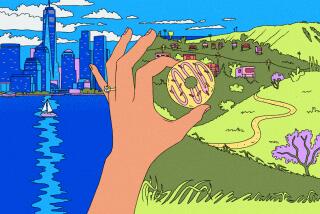Have Car, Will Travel Bumpy Road of Life
- Share via
The couple in the next lane is having a fight. One of those car fights that begins with a less-than-complimentary observation muttered almost, but not quite, out the passenger-side window, then moves into a heated exchange of invective directed at the windshield, and usually results in the driver making an unnecessary left turn just to do something, which causes the passenger to roll eyes heavenward before turning back to the window to stare and sigh and possibly begin the whole process again.
The fight in the next lane has actually progressed to a rare exchange of eye contact, which makes it difficult for the driver to roar away cleanly, which he undoubtedly would like to do, the minute the light changes. Instead he attempts to yell and glare and roar at the same time, and the result is a choppy acceleration that stalls the vehicle and will undoubtedly send the conversation well into Defcon 4, because there are, after all, few public acts as humiliating as stalling your car at a light, even if you aren’t in the middle of defending your general competence as a human being.
They do not teach you this in driver ed: how to fight in the car without stalling it.
In driver ed, they are very concerned with acceleration and braking, mirror checks and turn signals, parallel parking and three-point turns. All of which are important skills to have, constituting as they do the physical act of operating an automotive vehicle. But driving, particularly in Southern California, is quite a bit more than that.
Americans now spend more time in their cars than ever (an increase of 43 hours a year between 1990 and 1995). Southern Californians certainly spend more time there than average Americans, and just for the record, Southern California women, particularly mothers, spend 20% more time in their cars than anyone, with the possible exception of New York cabbies.
And they aren’t just driving.
Who has time to just drive? They are talking, singing, arguing, listening, thinking, eating, combing their hair, reading a book, drinking their coffee, feeding their children, teaching their children, grilling their children, courting, consorting, consoling, setting the terms of marriage and/or divorce, making out, making up, finding God, finding change, changing lanes, changing shoes, changing directions completely.
Of course to safely drive an automobile, you should confine yourself to just that. But we live in a car culture, and car culture is not about hood ornaments and sound systems; it’s about doing everything human beings do in the confines of a car. Love, hate, ambition, revenge, sorrow, joy, lust and laughter--all the biggies in a 20-square-foot interior separated from the rest of the world by a few inches of glass.
Driving is a public act, and to a certain extent, a communal public act. And yet there is an odd perception of privacy that allows us to engage in acts of intimacy--vicious conversations or personal grooming--that we wouldn’t dream of conducting at, say, a dinner party. And yet, there it is two feet away from you, on the corner of La Cienega and Sunset.
On the other hand, the car can be a haven, soothing the most colicky infant, and a confessional, allowing a sullen teen the opportunity to admit a failing to the windshield.
They do not teach you this in driver ed, that our car is our biosphere, carrying us and all our baggage, worldly and emotional, from one place to another. A place both safe and perilous, by which and in which we negotiate life.
Of course, being able to parallel park doesn’t hurt either.







